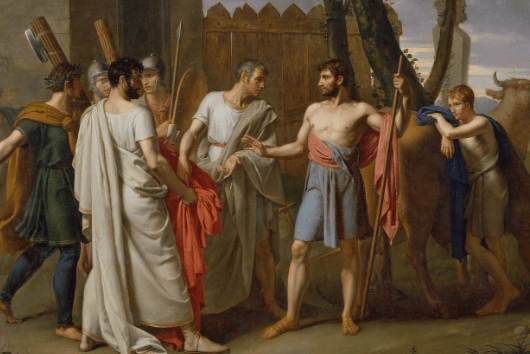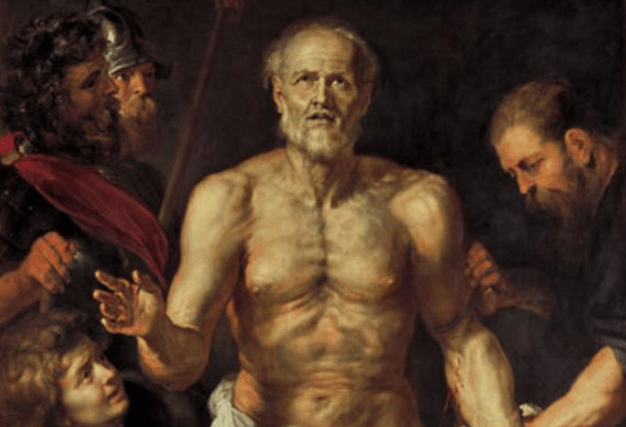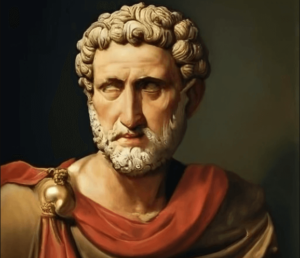There was a time when the Roman Empire boasted the most extensive political and social structure in the history of ancient Western civilization. At the height of the empire in the 1st and 2nd centuries AD, ancient Rome occupied a land area of 6.5 million square kilometers and had an estimated 50 to 90 million inhabitants.
Ancient Rome gave birth to many famous figures such as Julius Caesar, Cicero, Augustus, and many more famous Romans who are still remembered today. But it also saw the reigns of infamous emperors such as Nero and Caligula.
Their regime of terror still sends chills down the spines of historians or just about anyone who reads about what life was like in that era.
Also, see 8 Greatest Generals in Ancient Rome
List of Top 10 Famous People In Ancient Rome

1. Spartacus
Without a doubt, the most famous gladiator in Roman history was Spartacus. Spartacus, a native of Thrace, was a soldier who was captured in war, sold as a slave, and served as a gladiator. However, as history has repeatedly proven, even if a soldier’s freedom is taken away, the warrior’s fierce will for independence will never give in.
Before he was enslaved and forced to fight in Roman arenas, not much was known about him because the Romans never bothered to record the early lives of gladiators. It is estimated that the number of slaves in Rome at its peak was approximately 1.5 million.
However, despite repeated slave uprisings, the Romans did not take them seriously. Those in power were resting on their laurels. First, Spartacus persuaded about 70 of his fellow gladiators to revolt and escape to the foot of Mount Vesuvius. Then, over about two years, until 71 BC, he freed and trained a large number of slaves to form an army of 70,000 men.
This immediately caught the attention of the Roman Senate, who sent several legions to fight the slave forces and kill Spartacus, but not before Spartacus left his mark on Roman history.
2. Marcus Licinius Crassus
A noble and very wealthy Roman, a follower of Sulla who became famous in 71 BC. Spartacus’ slave revolt was brutally suppressed. In 60 BC he became a member of the First Triumvirate with Caesar and Pompey and was appointed consul in 55 BC.
While serving as governor of Syria, he organized a military expedition against Parthia. This ended in a crushing defeat at Carre (known today as Haran, Turkey), where the legion’s insignia was lost and he lost his life.
3. Gaius Julius Caesar
A representative of the popular faction and a member of the Julia family, presumed descendants of Aeneas, he had a brilliant political career and formed the first triumvirate with Crassus and Pompey in 60 BC. He became consul in 59 BC.
He conquered Gaul and even Britannia. His Senate and Pompey deprived him of military power. In 49 BC, he led his army across the Rubicon River and then the Italian border and engaged in a bloody civil war with Pompey. His victory made him the undisputed leader of Rome.
He was consul for five years (48 BC) and dictator for ten years (46 BC). Thanks to his authority and the wealth he acquired, he initiated a series of legislative reforms and built many important monuments.
Much of his work was interrupted by a deadly conspiracy perpetrated by Brutus and Cassius. Upon his death, he was designated a god and worshiped in a temple erected in the Roman Forum at his crematorium.
4. Marcus Antony
Caesar’s grandson and lieutenant. He was a key figure involved in the revenge against Caesar’s assassins Brutus and Cassius. In 43 BC he formed the Second Triumvirate with Lepidus and Octavian, which divided Roman territory and assigned the eastern region to Mark Antony.
He fell in love with Cleopatra, married her, gave her much of his Roman fortune, and came into open conflict with the Senate and Octavian. The civil war ended with a naval battle at Actium in 31 BC. Mark Antony committed suicide in Alexandria in 30 BC.
5. Cleopatra
Daughter of Tolomeus Auletes, king of Egypt. After her father’s death, she was taken away by her husband and her younger brother, Tolomeus Dionysius. In 46 BC, she ascended the throne once again thanks to Julius Caesar, who gave birth to her son by cesarean section.
After her dictator died, she married Mark Antony, with ambitious plans to establish a strong rule throughout the eastern Mediterranean, and she fought Octavian directly.
After the defeat at Actium (31 BC), she committed suicide by being bitten by a poisonous snake. Marcus Aurelius (Marcus Aurelius Antoninus: 121-180 AD) ruled with his adopted brother Lucius Verus, who died in 169 AD.
Despite his peaceful and ascetic nature, Marcus Aurelius had to face long wars with the Parthians in the East and pressure from the Quads and Marcomans along his northern frontier.
These battles are depicted in the Antonine Column. In addition to these difficulties, his reign was marked by a series of epidemics and a difficult economic crisis that marked the beginning of the empire’s decline, further accentuated by the poor rule of his son and successor, Emperor Commodus (Lucius Aurelius Commodus). From 180 to 192.
The bloody civil war that broke out with the death of Commodus ended in 193 AD with the victory of Lucius Septimius Severus (144-211 AD), emperor and first of the Severian dynasty. Born into an Italian family at Leptis Magna in Tripolitania (now Libya), Septimius Severus led a victorious expedition to the East that reorganized the Roman Empire and its defenses and allowed the annexation of Mesopotamia.
6. Caius Julius Caesar Octavianus Augustus
Born into a plebeian family, Octavian was designated as the son and heir of his uncle Julius Caesar. So he changed his name to Caius Julius Caesar Octavianus.
On the death of the dictator, with Mark Antony and Aemilius Lepidus, he established a second triumvirate, but after the final defeat of the Cesareans at Philippi (42 BC) the possibility of dividing Roman territory into three parts quickly disappeared.
The Civil War broke out and Octavian and Mark Antony, who was already married to Cleopatra, became enemies. The victory at Actium in 31 BC enabled the young Caesar to conquer absolute territory over Rome. This was formalized in 27 BC when the Senate granted him the title Augustus (later passed on to all future Roman emperors).
Having seized all power, he radically reorganized the Roman state through a series of legislative, administrative, and social reforms, ushering in a long period of peace known as the New Golden Age.
During his reign, Rome, along with all other cities of the empire, engaged in an extensive construction program, from the restoration of ancient monuments to the construction of new architectural complexes. In his will, Augustus could proudly claim that he had founded a city built of brick and left behind a city built of marble.
7. Nero Claudius Drus us Germanicus Caesar
The son of Agrippina Minor, who became Claudius’ adopted son and became emperor in 54 AD. After an initial peaceful leadership, the young emperor changed his political line and emphasized despotic tendencies towards an absolutist monarchy.
His name is associated with luxury, but above all with his attempt to blame Christians for the serious fire and conflagration that destroyed most of Rome in 64 AD.
His eccentric behavior and political line were directly reflected in the accomplishment of important architectural programs such as the Domus Transitoria and Domus Aurea, the luxurious and magnificent palaces that Nero built as his residence.
Following a series of plots, Nero committed suicide during a revolt led by his governor in 68 AD, ending the Roman Empire’s first dynasty, Julius Claudius.
Despite his peaceful and ascetic nature, Marcus Aurelius had to face long wars with the Parthians in the East and pressure from the Quads and Marcomans along his northern frontier.
These battles are depicted in the Antonine Column. In addition to these difficulties, his reign was marked by a series of epidemics and a difficult economic crisis that marked the beginning of the empire’s decline, further accentuated by the poor rule of his son and successor, Emperor Commodus (Lucius Aurelius Commodus). From 180 to 192.
Conclusion
Ancient Rome has a very rich history with the rise and fall of many famous people who are still talked about today. From the craziest emperors and bravest gladiators to some of the biggest names in ancient philosophy, ancient Rome has given us its fair share of notable figures.
This list probably doesn’t do the topic justice. That’s because there were many other famous Romans who could have easily been included in the list. However, since we have to choose only 7, the Romans mentioned above are truly outstanding figures in Roman history.

